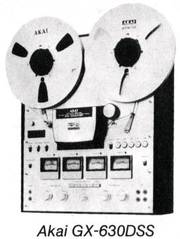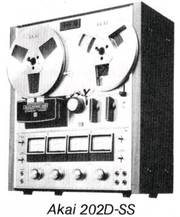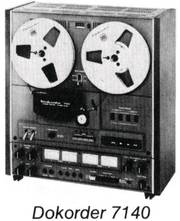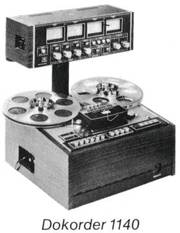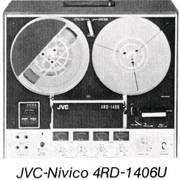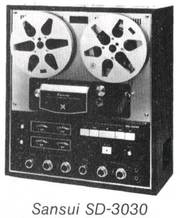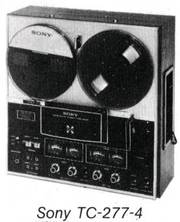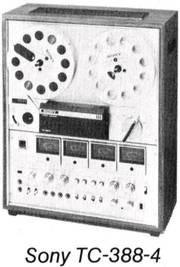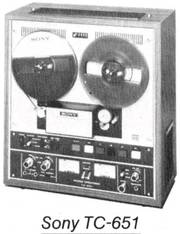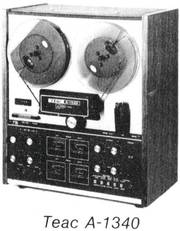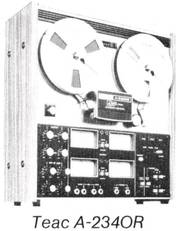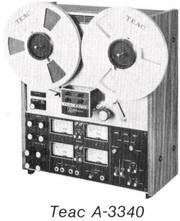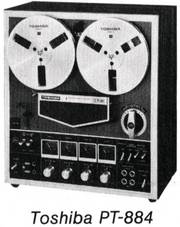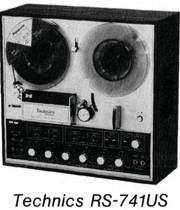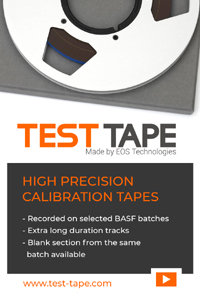"off duty" 1970 - 1997 - eine Freizeit-Zeitung für's US-Militär
Die in diesem amerikanischen (Freizeit-) Shopping-Magazin angepriesenen Hifi- und Video-Produkte waren auschließlich amerikanischen und kanadischen Militärangehörigen zugänglich - also zu kaufen - und vor allem zu ganz ungewöhnlich (verblüffend) niedrigen US $ Military-Preisen. Zu der einführenden "off duty" Seite geht es hier lang. - Um 1970 begann der weltweite Hifi-Boom bis zum 1. Crash 1978 und dann wieder zum 2.Crash um 1990. Über die 20 Jahre nach 2001 lesen Sie mehr in den Kolumnen auf diesen japanischen Seiten.
.
Open-Reel Tape Recorders
Bandgeräte Besonderheiten im Juni 1975
Eigentlich war analoges 4-Kanal Quadro im Sommer 1975 ja schon tot. Jedenfalls, wenn der wichtigste Audio-Markt der Welt dieses "Quadro Zeugs" nicht mehr kauft, ist der Zug abgefahren. Dennoch kommen immer neue open reel Quadro-Boliden auf den Markt und auch hier wird nirgendwo auch nur angedeutet, wie man echte Quadro-Musik da drauf bekommt und vor allem, wo man die Quadro-Musik überhaupt her bekommt. Denn diese ganzen echten Quadroaufnahmen konnten ja nur in Musik-Studios entstehen, wo sonst.
Die Anzahl der ganz großen Bandgeräte überrascht schon, weil auch hier nur die im europäischen military Vertrieb angebotenen open reel Modelle aufgeführt sind. Übrigens ist hier von TASCAM und FOSTEX noch immer keine Rede.
.
Introduction - OPEN-REEL TAPE RECORDERS
OPEN-REEL TAPE RECORDERS have been a factor on the music scene ever since the post-war years (seit 1947). While their use then was primarily by professionals, such as broadcasters, open-reel's virtues soon attracted the attention of audiophiles.
Today, although there are other tape formats available, open-reel machines are still favored by professionals and many advanced audiophiles.
While it is true that cassette and cartridge units have taken great strides, open-reel machines still offer the ultimate in versatility. An increasing number of them can even accommodate 10 1/2-inch reels to allow hours of uninterrupted listening. And, unlike smaller format machines, open-reel equipment offers several different speeds.
Easy editing is another advantage of the open-reel format. Cassettes and cartridges are all but impossible to edit, but with open-reel tape it's no problem.
Also, smaller format machines don't allow you to create the elaborate special effects that are possible with open-reel units. Multi-track features built into some machines allow you to do things that were once the sole province of recording studios.
And the quality, while not up to that of a $200,000 custom-built installation, can be as good or better than what was considered professional quality a few years ago. Likewise, if you are interested in top-quality discrete 4-channel recording or playback, open-reel systems provide the best performance.
Mechanics
.
Motors and drive systems.
Most of the better machines use separate motors for both the rewind and the take-up spools, while yet another motor drives the capstan. In many instances the capstan drive motor is a special low-speed type in order to help reduce flutter and wow.
There are also many one and two motor machines on the market. They, too, can offer fine performance although they require more mechanical components. Many of these machines will use a servo-controlled motor to help insure constant speed. Some machines will also have two capstans instead of one. Dual capstans are useful in reducing flutter and wow.
Speed and reel size.
Most recorders are designed to operate at two or three selectable speeds such as 1 7/8, 3 3/4 or 7 1/2 inches per second (ips). The higher the speed, the better the performance, other things equal. Most people will find thatthe 3 3/4 or7 1/2 ips speeds give fine results. If you've found that the fidelity at 7 1/2 ips isn't to your liking, look for a machine that offers the 15 ips speed.
Performance will be even betterand editing easier, too. Then again, if you aren't really demanding, you might find that recordings made at 3 3/4 ips are satisfactory, particularly if you use the Dolby noise reducing system during recording and playback.
Besides, the slower the speed, the greater the playing time for a given length of tape. If you plan to record at 15 ips or if you want hours of uninterrupted, full-fidelity music, then consider a machine which accommodates professional-size 10 1/2-inch reels.
.
Transport operation.
Several open-reel machines will automatically reverse direction at the end of one side of a tape, then play the other side. This bidirectional feature, of course, makes such machines more costly than those that operate in one direction. The increased cost, many feel, is offset by the added convenience of not having to reverse reels-which is simple enough, but does require you to get out of your chair.
Most machines' auto-reverse systems are activated by a small length of metal foil placed at each end of the tape. However, machines now are available that monitor the tape and, after a certain period when no recorded signal is present, reverse themselves, eliminating the need for foil strips.
Along the same line, many machines have solenoid controls that need just a touch to operate. These usually work in conjunction with "logic" circuits that prevent any accidental damage to the tape. Solenoid controls easily lend themselves to the use of remote control, too.
Electronics
.
Heads.
The heads on any tape recorder are tremendously important and very tricky devices since this is where mechanical and electrical activity merges. Not only do the heads have to be extremely well designed, but they must be held in an absolutely rigid predetermined position.
Construction of magnetic recorder heads has received a lot of attention from manufacturers with the result that many machines now have long wearing special ferrite heads as standard equipment. These new heads have the same basic construction as previous heads but are made with high densityferrite materials which wear much longer than conventional heads. In some cases, glass coatings are also used with the ferrite for added durability.
The number of heads in your recorder may be important to you, but in some cases is difficult to determine. If your machine is designed for playback only, it will probably have only one head. If it is designed for record and playback then it will probably have at least two heads-one for erase and one for recording and playback.
On the other hand, if it has three heads, it will probably have separate record and playback heads, yiving the advantage of reduced switching and providing tape monitoring during recording. If the machine is a bidirectional model it will probably have more heads - up to six in all - to take care of the additional functions.
And, you'll find reverse playing machines with special heads that change position when the machine goes into reverse play. A few others use a crossfield recording system that requires a special head opposite the record head.
As a rule, most of the machines in our listings are four-track stereo models. That is, two stereo tracks are recorded in each direction. However, there are other head formats available, such as half-track stereo which records two wide tracks per tape. Generally the other head formats are of interest only to professionals.
The primary exception to this is the four-track head for recording or playing discrete 4-channel quad. Many of these 4-channel units are also equipped to record fourtracks one-by-one as might be done in a recording studio.
Thus, you can record, one-at-a-time, a bass guitar on track one, drums on track two, guitar on track three and voice on track four. If you don't like, for example, the drum track, you can re-record it while listening to any of the other tracks. This simultaneous play/record feature makes it possible to have all the tracks in perfect synchronization.
Tape selection switches.
Different kinds of tape require different bias and equalization settings for best performance. Unless you plan to stick to just one type of tape recommended by the machine's maker, then you'll probably want to keep an eye open for a unit with switchable bias, equalization or both.
Noise reduction.
Open-reel machines are usually less troubled by noise than equipment for the smaller tape formats. For that reason, there is less need for noise reduction circuitry. However, if you plan to do a lot of re-recording (which increases noise), or if you are an especially critical listener, a good noise reduction system may prove a valuable asset.
By far the most popular system is the Dolby Type B. Some machines have Dolby circuitry built-in, but if the model you choose does not, you can buy a separate or "outboard" Dolby unit. Several manufacturers also offer their own, less sophisticated, noise reducing approaches.
Recording meters.
If you're interested in making quality recordings, then pay particular attention to the type of recording level meters offered. Some give an averaged reading, others peak levels. But even the best meters cannot respond fast enough to some peaks, especially when recording live music. That's why light emitting diodes (LEDs) are used in conjunction with some meters. They flash on the instant a powerful peak occurs.
Performance
.
Frequency response.
This is a very important specification to keep in mind. Many machines claim an overall record/playback frequency response of 30-20,000 Hz or better, plus or minus three decibels, at 7 1/2 ips. Of course, at slower speeds frequency response will not be this good.
Signal-to-noise ratio.
Although open-reel tape recording is less troubled by noise than its smaller cousins, it is nonetheless something to keep in mind if you are interested in high-fidelity performance, particularly if you plan to do a lot of tape copying.
The relationship of the signal level to the noise level is the S/N or signal-to-noise ratio. It is expressed in decibels, for example, S/N 50dB. S/N ratios have steadily improved (gotten higher) over the past few years - they were commonly in the high 40s - but now it's not unusual to find machines with S/N ratios of 60dB even without special noise reduction circuitry.
With careful use of a recorder, low noise tape and Dolby noise reduction circuitry, today's audiophile can expect S/N ratios of 65 to 70dB.
When selecting a recorder, your lower limit for a S/N ratio should be 50dB and, of course, as much higher than that as possible. Someof thesmall portable or inexpensive machines may not be able to meet this limit, but most of the quality stereo units listed will pass the test easily.
Flutter and wow.
The tape should move past the heads at a constant speed. Momentary variations in speed are known as flutter, longer-term changes are called wow. The less of them, the better. Special motors and drive systems help reduce the amount of flutter and wow. Look for machines with the lowest figures, preferably not greater than 0.15 per cent.
Power output.
If an open-reel machine is a recorder, that is, it has a built-in power amplifier, the manufacturer must conform to the Federal Trade Commission's power rating regulations if the advertised output is more than two watts per channel.
Other features.
Many machines have several microphone and line inputs, plus mixing controls. These can come in handy if you decide to do some live recording. Separate external mixers are available, too. Also, as we mentioned, remote control units are available for many machines. Cueing controls, output level controls and provisions for DIN connectors are other features you may wish to keep in mind.
Except where noted, the figures given in the listings are based on operation at the 7 1/2ips speed.
.



